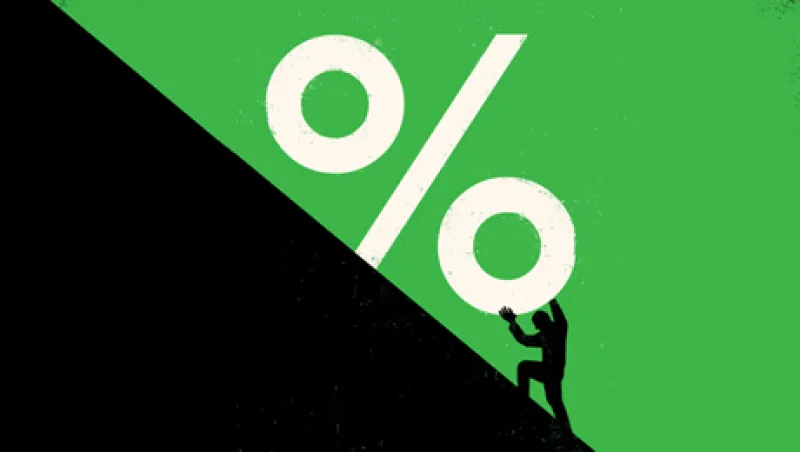Negative interest rates are nothing new in Europe, where some central banks have effectively been charging depositors since 2014. But if rates stay below zero much longer, the region’s banks and institutional investors may have to rethink their portfolios to keep afloat.
Deutsche Bank, Germany’s biggest lender, has lost half of its market value this year as it struggles to boost earnings in a negative-rate environment. Several recent scandals, including a U.S. Justice Department probe of its mortgage-backed securities business that could result in fines of up to $14 billion, have helped send the bank’s stock to a historic low.
Deutsche CEO John Cryan has warned that the adoption of negative rates by the European Central Bank, whose overnight deposit rate sits at an all-time low of –0.4 percent, could have “fatal consequences” for pension funds and savers. International Monetary Fund chief Christine Lagarde took aim at Deutsche in a recent interview, asserting that even if the bank resolves its legal troubles, it must consider big changes to its business model in light of negative rates and lower earnings expectations for the European banking sector.
As Deutsche looks for a pathway back to health, it may be able to draw lessons from its regional peers. In Switzerland, for example, banks have offset the cost of the current monetary policy by expanding mortgage lending at a higher interest rate; Danish banks have focused on fees by doing things like charging depositors for a broader range of account types and hiking the cost of flexible-rate loans. Those are the kinds of moves central banks hoped to encourage by introducing negative rates, but such measures are unlikely to maintain stability over the long haul.
Danmarks Nationalbank was the first European national central bank to push its deposit rate into negative territory, three months after the ECB kicked things off in June 2014; this decision created uncertainty for the country’s banking sector, but it’s been able to rebound. “Danish banks had one of their best years in 2015,” Lars Rohde, chairman of the board of governors, tells Institutional Investor. Still, policymakers must remember that negative rates may undermine the banking industry and make life tough for Europe’s large public pensions if they can’t earn interest on their assets, Rohde warns.
“Unlike some central banks, we aren’t inflation targeting,” he notes, pointing out that Danmarks Nationalbank is focused on maintaining the peg between the euro and the Danish krone. The Danish central bank’s current rate is –0.65 percent, but it could go even lower if necessary to maintain the peg, potentially creating new headaches for the nation’s banks. “We have intervened in order to keep the peg alive, successfully,” Rohde says. “But central bankers can’t be the only game in town.” Denmark and the European Union will have to start using other policy levers to promote economic development, he adds.
The fate of bank earnings and conservative institutional portfolios are entwined as European markets struggle to find a new equilibrium. “It’s difficult to explain to clients that holding high levels of cash right now is a negative,” says Dieter Enkelmann, chief financial officer at Julius Baer Group.
The Zurich-based bank has talked to its clients about switching some of their euro-denominated positions into dollar-denominated investments, but the risk appetite is very low, Enkelmann adds: “Even if there is only a marginal currency risk, they aren’t interested.”
Since 2008 the cash portion of client portfolios at Julius Baer has ticked up from the teens to about 25 percent on average, while investment transactions have dwindled. As cash positions in individual accounts rise, forcing European banks to pay more to central banks for holding their money, credit spreads have tightened as a result of quantitative easing, leaving banks scrambling to generate profits for themselves and returns on investor portfolios.
“Negative interest rates are impacting our business model,” Enkelmann says. Julius Baer, which has shelled out some SFr14 million ($14.3 million) so far this year to keep its money with central banks, is taking steps to limit the number of institutional accounts hoarding euros on its balance sheet. Unless a client has an investment relationship or another type of account with the firm, it may charge them more to stockpile cash.
“Banks are asking themselves, ‘How long can we bear this burden before we have to pass it on to our clients?’” Enkelmann says. If a big bank came out and said, ‘We are charging,’ probably the majority would follow.”
Switzerland’s Migros Bank has been charging institutional clients for cash deposits since April 2015, in addition to making mortgage lending more expensive. Those premiums, which can impact the overall funded status of pension plans and hit institutional returns, have prompted some institutions to increase their risk tolerance by starting to issue mortgages on their own. Insurers and pension funds that have opted to do this are offering lower interest rates than the banks in exchange for a direct cut of the action, says Migros spokesperson Urs Aeberli.
The private market may also hold other opportunities for investors, like acquiring bank assets and turning them around. Jack Yang, head of the Americas and global head of business development at $28 billion asset manager Alcentra, says negative rates policy in Europe supports his London-based firm’s investment outlook. “It preserves and extends the opportunity set for direct lending of private capital and opportunistically buying assets because banks will be more aggressively looking to sell and delever,” he explains.
Yang expects to see more deals as Basel III regulations, which require banks to have bigger capital buffers and maintain a stable of higher-quality assets, take effect in 2019. “Banks have to get serious about their cost of capital and getting rid of assets on their balance sheet,” he says. “You can’t keep kicking the can down the road when earnings aren’t there.”
Get more on banking.






